Your Ultimate Guide To Unusual, Unconventional, And Downright Surreal Ways To Display The Time
Beyond the conventional twelve hours and two hands, are whole new wristwatch worlds.
Pick any watch at random and chances are, it will have hour and minute hands, and twelve markers for the twelve hours. The circular nature of time displays goes all the way back to sundials and such displays are a natural result of clock and watch gears, with their circular motion. The division of the day into 24 hours goes back very far – to the Egyptians and Babylonians – and so in most cases, watchmakers despite the almost infinite variety of styles and designs they’ve come up with, all still rely on the same basic display.
However, there is as they say more than one way to skin a cat, and, especially over the last century or so, alternative means of showing the time have appeared with increasing frequency in watch and clockmaking – in fact there are entire brands, like MB&F, which essentially have a new way of displaying the time for every new watch.
24 Hour And Backwards Dials
The first and simplest variation on the conventional display is probably a dial showing 24 hours instead of 12. The Glycine Airman is an early example, and there are several variations on the theme from Breitling, including the Cosmonaute, and a 24 hour version of the Chronomatic. Generally, 24 hour dials are associated not with aesthetic innovation, but with practicality; the 24 hour system is usually associated with the military and with commercial and military flight operations.

Last year at Watches & Wonders Cartier came out with a watch that looks at first glance like a standard 12 hour, two hand design, albeit of the noble and revered Santos-Dumont, which is arguably the oldest series produced wristwatch design in the world. Look closer, though, and you’ll see that something’s fishy about the dial.

The XII and VI are right where they are supposed to be but the numbers run backwards around the dial, with the I where XI should be and that’s because the hands run backwards as well; the watch in question is the Santos-Dumont “Rewind.” There are maybe more obviously different time displays, but I can’t think of any that are more confusingly subversive. I would imagine you’d get used to it eventually (I’d love to have an opportunity to try although given the fact that the watch was a limited edition – 200 in gold and 200 in platinum – and how fast Cartier LEs sell out these days, I doubt I ever will). The watch on launch produced any number of reactions, from confusion to outright rejection, but I thought it was cool.
Jumping Hours And Digital Time Displays
One of the more common ways to show the time if you want to do something other than standard dials and hands, is to use a digital time display of some sort. Jumping hours are the most common, often combined with a conventional minute hand and seconds hand but not always.
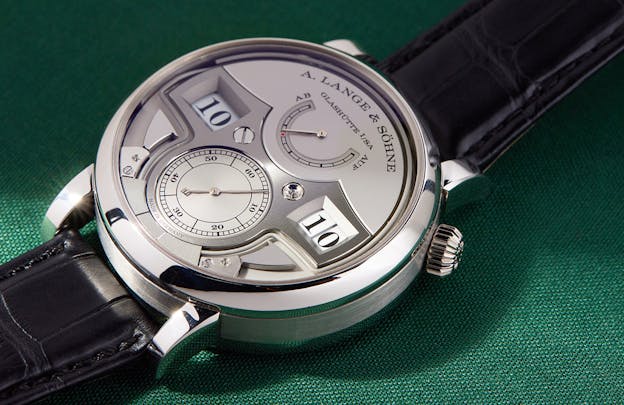
The Lange Zeitwerk is probably the best known modern example of a jumping hours watch, and it’s also a great example of why most watches stop at a jumping hours display. The Zeitwerk has a jumping hours display on the left and a jumping minutes on the right, and all indications switch instantaneously. The amount of energy needed to switch all of the numbered disks at the same time is considerable and in order to provide the requisite juice and avoid power drops that might upset precision, the Zeitwerk is equipped with a constant force remontoir, and a large, powerful mainspring.
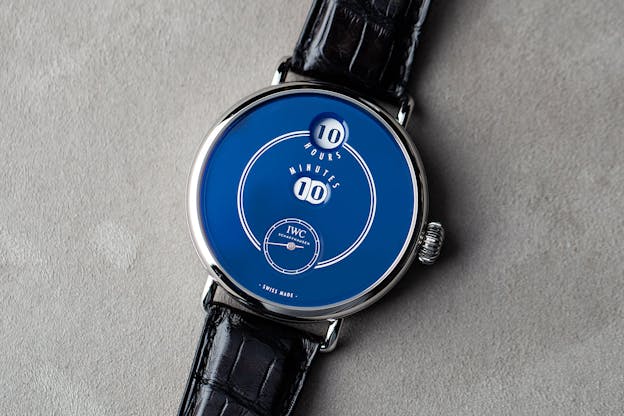
One of the earliest all digital – or almost all digital – watches was IWC’s Pallweber, which in its original form was produced as a pocket watch in the 1880s. IWC produced a wristwatch version of the complication for its 150th anniversary in 2018, retaining the vertical in-line layout of the original, and like the Zeitwerk, the IWC Pallweber showed the hours on one disk, the minutes on two, and the running seconds in a sub-dial.
Among independent watchmakers some of the most famous digital jumping display watches are the F.P. Journe Vagabondage series, which Journe made in three versions of increasing technical complexity with each new version.

They’re all fascinating watches and very much off the beaten path for Journe, whose design language is otherwise pretty consistent from one collection to the next. The most technically complex Vagabondage is the Vagabondage III.
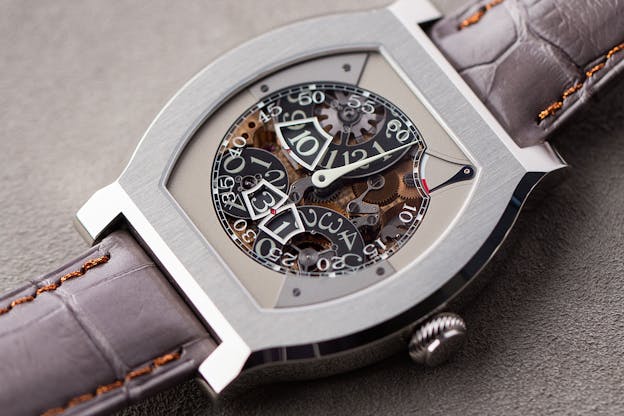
The Vagabondage III is as far as I know, the only digital jumping display watch anyone has ever made which has a jumping seconds display. The jumping seconds are at 6:00 on the dial, and the seconds disk on the right jumps once per second, with the disk on the left jumping once every ten seconds. The hours are shown on a jumping display at the upper right and the minutes are shown by a conventional center minutes hand. In order to manage the power drain when the disks jump, Journe, like Lange with the Zeitwerk, used a train remontoir.
The Wandering Hours Display
Another way of displaying the time digitally is the wandering hours complication. The complication was originally developed, as far as anyone knows, by the Campani brothers in 1656, for Pope Alexander VII – the Campani version had room inside for a candle which lit the translucent dial from behind; the Pope wanted to be able to tell the time at night but without relying on hammers and gongs.
A wandering hours watch is so-called because the hours literally “wander” across the dial. Wandering hours watches use a system of satellites on which the numbers for the hours are mounted and the satellites travel in turn across a sector on the dial marked out in minutes. One of the best, and best known, modern examples of a wandering hours complication was Audemars Piguet’s Star Wheel, which is very much a celebration, in the context of an unusual time display, of traditional high-grade watchmaking.

The satellites are held in place by star-shaped wheels (hence the name of the watch) and each rotates a quarter turn to line up the correct number for the hour.
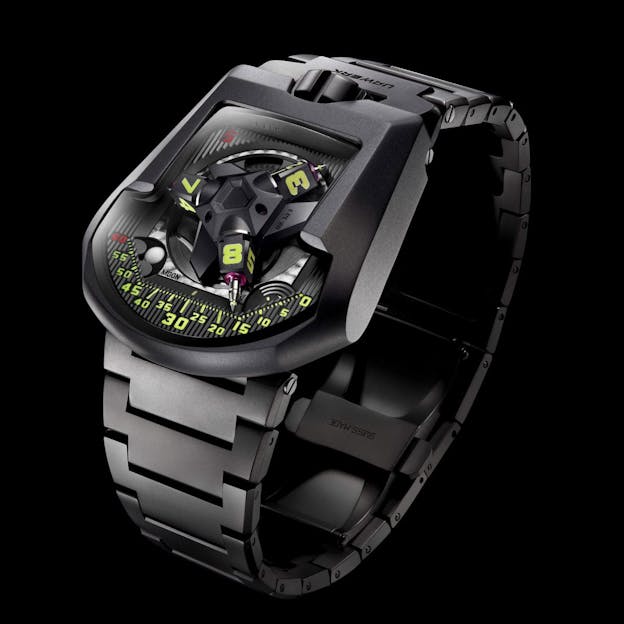
A quite dramatically different take on the wandering hours display is from URWERK, who have built their entire brand around the wandering hours display and variations on the original design. The UR-202 for instance, is technically a wandering hours display but with some major design and technical differences when compared to a traditional version like the Star Wheel. One notable technical difference is that the satellites in the URWERK design are not disks, but rather, rotating cubes.
Retrograde Time Displays
Retrograde displays are pretty straightforward – the hours, minutes, and sometimes seconds are shown by hands which move along a curved sector and which jump back to the starting position when a given period of time – an hour, in the case of a retrograde minutes display – has elapsed. Gerald Genta made extensive use of retrograde hands, in his Retro Fantasy watches and other designs, often combined with a jumping hours indication.

The Moser Pioneer Retrograde Seconds “Midnight Blue” is an example of a retrograde seconds display – a 30 second retrograde seconds display, with the seconds hand jumping back every thirty seconds.
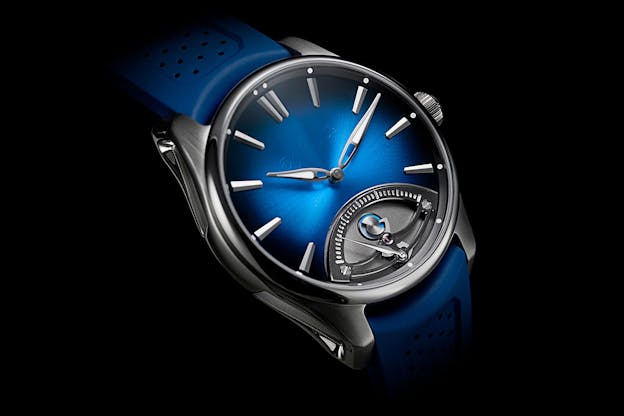
The Moser has the added interest of showing how the complication works – the seconds hand pivot is mounted on a spiral spring, and it’s geared to a rack whose nose is in contact with a rotating cam with two steps. As the cam rotates, the rack moves the seconds hand along its track and at the 30 second mark, the nose of the rack drops down the step on the cam, flicking the seconds hand back to its start position.

The basic engineering solution of stepped cams and racks performing various functions can be found in a wide range of watchmaking complications – in retrograde displays, but also in repeaters and perpetual calendars as well.
Linear And Roller Displays
Now we’re getting into some really exotic and borderline weird stuff. Linear displays don’t have circular or curved time displays – instead, the time is shown along a straight line, sort of like old-fashioned linear speedometers in cars, if you’re old enough to remember what those looked like. You wouldn’t think of Patek Philippe messing around with something so unusual – after all this is the company that made the reference 96 for forty years straight – but in your personal list, if you have one, of watches with oddball displays, make room for the often forgotten Cobra, ref. 3414, with a movement by Cottier and a case by Gilbert Albert.
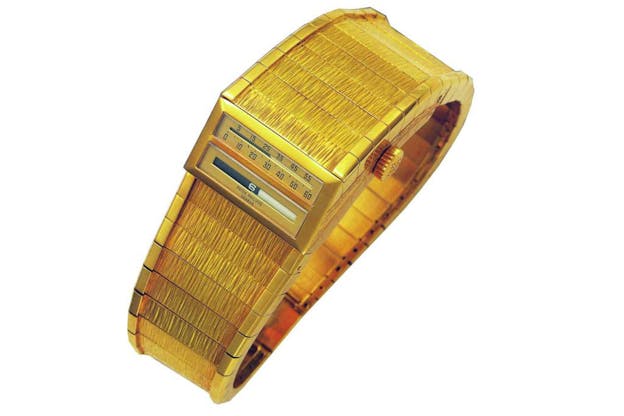
The Cobra, which was never put into production (the sole example, a prototype, is in the Patek Philippe Museum in Geneva) is one of a very small number of linear display watches, which often use a roller hidden under the case to produce a linear display. Another example is from URWERK.
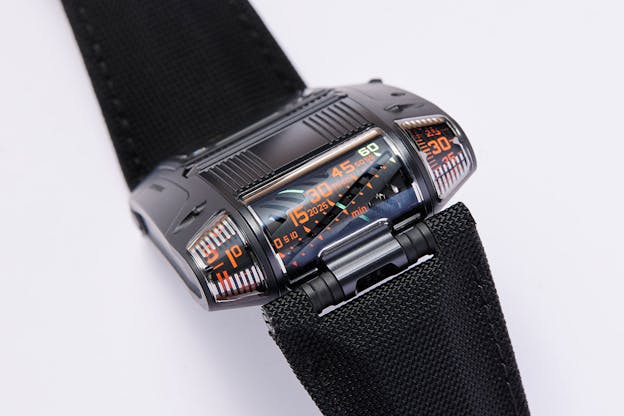
If you are looking for an unconventional time display that out-unconventionalizes every other unconventional time display, the UR-111C is not a bad place to look. On either side of the linear roller, there are two digital cones showing the hours and the minutes, and in the center is a roller display showing the minutes as well, with some selectively applied lume at the 60 minute mark and on the helical groove of the roller itself. URWERK launched another linear display timepiece in 2009 – the UR-CC1 – which is a little bit more directly connected to both the Patek ref. 3414 and to some of the really out there linear display watches from the 1970s, like the Lip Secteur.
And then, beyond all these, are the truly strange one-offs – single model or single family watches which have such unusual time displays that no one in their right mind would try to imitate them.
Unusual Time Displays: Basically Every MB&F
MB&F is such an established presence in the watch collector universe that it is no longer even necessary to explain what the letters stand for, but with the gradual shift from disruptor to institution has come a slightly pervasive lack of recognition of what Max Büsser’s work represents. If we are talking about unusual time displays it is worth remembering that basically, every Horological Machine without exception represents an unusual time display and, on top of everything else, with a new mechanism for every Horological Machine as well. One of my fondest trade show memories will always be wearing an HM3 at SIHH, and having almost everyone – watch collectors and brand presidents alike – stop in their tracks asking to see it.

The first MB&F watch that I ever saw in person was HM2, in 2008 – I had lunch with Max at the Museum Of Modern Art (an apt location) and I was floored. HM2 is an ingot of gold with instantaneous jumping hours, concentric retrograde minutes, retrograde date, bi-hemisphere moon-phase and automatic winding, on a manga-battleaxe shaped central rotor, built on a base caliber from Girard-Perregaux.
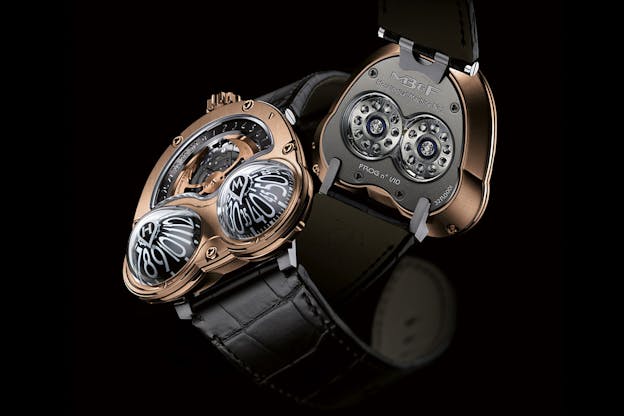
The HM3 “Frog” is another example of just how far imagination can go in watchmaking and seen in retrospect from the perspective of 2024 it is something of a rebuke to the general risk-averse attitude and lack of imagination prevalent in so much modern watchmaking. That it is extremely difficult to tell the time is irrelevant; the Horological Machines are the ultimate examples of what can happen, in a good way, if instead of asking Why, you ask, Why Not.
Unusual Time Displays: Basically Every Harry Winston Opus Watch
The Harry Winston Opus series of watches are, more or less, totally forgotten by newer watch collectors – by “newer” I suppose I should clarify that I mean anyone who got interested in watches after 2015, when the last Opus watch was launched – Opus 14. It is no coincidence that the Opus series were the brainchild of none other than Max Büsser, who launched the initiative in 2001 with the idea of creating collaborations between Harry Winston and an independent watchmaker who would be given a clean slate and a blank check to create something extraordinary.
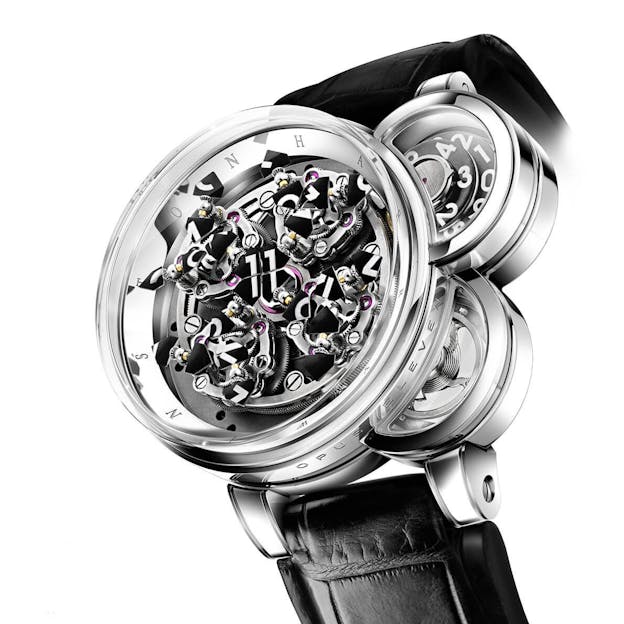
The Opus series used to be the highlight of every Baselworld trade show – another apparently immutable fixture of the watch world which has been forgotten with remarkable rapidity – and the watch press and enthusiasts used to look forward to the new Opus every year with the avidity of children wondering what is underneath the wrapping of an especially big present under the Christmas tree (your midwinter holiday celebrations may vary according to belief and denomination but I think you get the picture).
They are all wonderfully absurd – the Opus 3, designed by Vianney Halter, was originally conceived as a watch with six portholes showing the time and date all in jumping digital disks and I think it took ten years after it was announced to get it to work, but nobody as far as I know asked for their deposit back. If you want to see just how far the Opus series went, check out a complete history at Quill & Pad. My favorite I think was the Opus 11, which is a sort of jump hour on steroids – as you can see from the picture, every hour, the satellites carrying tiles with fragments of the hour number on them would rotate into position in the center of the dial. It was absurd and totally impractical and totally remarkable. Come for the Opus 11, stay for a mechanical version of a G-Shock.
Unusual Time Displays: Basically Every Ressence Oil Filled Watch
Ressence has produced a very convincing number of variations on the ROCS – the Ressence Orbital Convex System, which involves satellites showing the various indications embedded in a rotating dial. The most iconic ROCS watches, however, are those with oil filled cases. The cases of Ressence oil filled watches are divided into an upper and lower half, with the upper half filled with silicon oil and the lower half containing the automatic base caliber.

The magic trick is this: the oil has the same refractive index as the sapphire crystal and the result is that the crystal seems to vanish, and the satellites seem somehow to float on the surface of the crystal itself. Behind the magic trick is considerable technical innovation but the result is a time display that you won’t forget any time soon.
Coda: This Celebration Of Geometry From Hublot
Hublot, for various reasons, gets dragged a lot by self-styled advocates of horological purism but they have done over the years some watches that are quite incredible. My personal favorites, as we are on the subject of unusual time displays, are the Sang Bleu models.
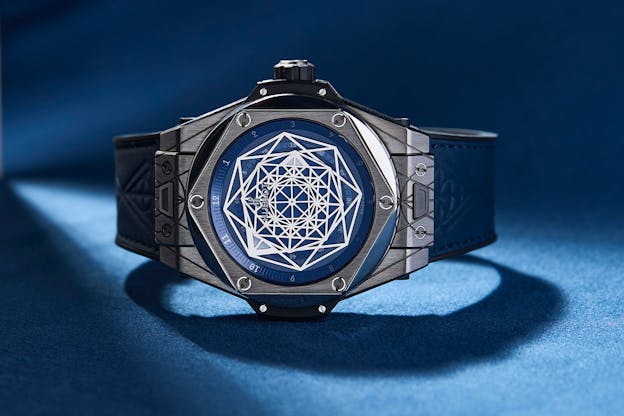
On a certain level this is a conventional watch – there are three concentrically nested octagonal geometric forms showing the seconds (center) hours (middle) and minutes (outermost). But it is unlike any other watch in how it shows the time and the interlocking geometric forms give you a sense of time you can’t get from any other watch. It’s mechanically straightforward, unlike the Opus, MB&F, or Ressence watches but at the same time it’s got a certain magic to it that makes telling the time an exercise in almost esoteric mysticism; the Sang Bleu Sapphire takes this design philosophy and pushes it to a really remarkable extreme. And despite all that has gone before it’s proof that when it comes to unusual time displays, there are still worlds left to conquer.
| Display Type | Example Watches | Key Characteristics |
| 24-Hour & Backwards Dials | Glycine Airman, Breitling Chronomatic 24H, Cartier Santos-Dumont Rewind | Displays full 24-hour scale or reverse direction; practical or visually subversive |
| Jumping Hours & Digital | A. Lange & Söhne Zeitwerk, IWC Pallweber, F.P. Journe Vagabondage III | Hours (and sometimes minutes/seconds) displayed digitally via jumping discs |
| Wandering Hours | Audemars Piguet Star Wheel, URWERK UR-202 | Hours “wander” across a minute track using satellite discs or cubes |
| Retrograde | Gerald Genta Retro Fantasy, Moser Pioneer Retrograde Seconds | Hands travel across an arc and snap back at reset intervals (e.g., 30 seconds) |
| Linear & Roller Displays | Patek Philippe Cobra 3414, URWERK UR-111C | Time shown along a straight line or with rollers; extremely rare and experimental |
| Horological Machines | MB&F HM2, HM3 “Frog” | Mechanically complex art pieces with unique layouts and jumping/retrograde displays |
| Opus Series | Harry Winston Opus 3, Opus 11 | Highly technical jumping displays; hour digits often constructed from moving parts |
| Oil-Filled Displays | Ressence Type 3 (ROCS) | Oil-filled rotating satellite discs appear to float on the crystal |
| Geometric Time Display | Hublot Big Bang Sang Bleu | Interlocking geometric forms represent hours, minutes, and seconds concentrically |

